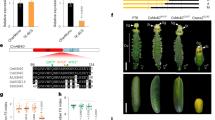Abstract
Barren in this context indicates the complete lack of female organs, not just flowers, but the absolute lack of even female (ear) initials in the maize plant. There are at least 5 non-allelic genes in maize that when mutated cause barrenness. This has been verified by extensive allelic tests. The phenotype of each of these genes is generally similar in the female part of the plant. There is a phenotypic change in the tassel, that is quite obvious in the plants in the field, though admittedly, this has not been exhaustively verified by sufficient out crossing. Most any maize geneticist or breeder that is familiar with plants in the maize genetic or breeding nursery has observed the relationship of the maturing male and female components in the plants. In almost every case (there are occasional exceptions) the male flowering and pollen-shed occurs before the female begins silking. The gap between the two events varies, from 1 day to almost the end of the pollen-shedding period. It has been anecdotally assumed that hormones in the tassel control the initiation of female activity. The tassel appears to repress the female receptivity (silking) until the pollen shedding begins. This is only anecdotal and the necessary experiments have not been made to clearly show this relationship. There are mutants that vary this process but these have not been coupled with physiological investigations. Though the ba4 mutant arose in a transposon plot, the necessary molecular confirmation of this mutant has not confirmed a transposon insert. The behavior of this mutant illustrates some interesting features. The mutant expression is characterized by plants that are typically barren. The barren plants are unilaterally susceptible to anthracnose. In a segregating row, only the barren plants show anthracnose disease symptoms. The factor that is deficient and causes barrenness is suggestive that the mutant effect makes the plant susceptible to anthracnose infection. This mutant is predominantly recessive but not entirely. In crosses of these barren (obviously, as male) on to assorted wild type plants (+/+ x ba4/ba4), there is a low frequency of “escapes”, that is, plants are ba4 and barren. But not entirely, because late, after the tassel has been fully spent, even dried, and probably 30 days, a small deformed ear appears on the very last leaf, very low in the plant. Hypothesis on ba4: That a hormone is suppressing ear formation and thus barrenness. When the plant is nearing senescence, the hormone is depleted and the ear initial finally becomes evident.
Access this chapter
Tax calculation will be finalised at checkout
Purchases are for personal use only
Preview
Unable to display preview. Download preview PDF.
Similar content being viewed by others
References
Baba, T. and Yamazaki, K. (1996) Effects of phase transition on the development of lateral buds in maize, Crop Sci. 36, 1574–1579.
Bonnett, O.T. (1940) Development of the staminate and pistillate inflorescences of sweet corn, J. Agric. Res. 60, 25–37.
Bonnett, O.T. (1948) Ear and tassel development in maize, Annual Missouri Botany Garden 35, 269–288.
Bonnett, O.T. (1953) Developmental morphology of the vegetative and floral shoots of maize, University of Illinois Agriculture Experiment Station Bulletin 568.
Bonnett, O.T. (1966) Inflorescences of maize, wheat, rye, barley, and oats: Their initiation and development, University of Illinois Agriculture Experiment Station Bulletin 721.
Cheng, P.C., Greyson, R.I. and Waiden, D.B. (1983) Organ initiation and the development of unisexual flowers in the tassel and ear of Zea mays maize, structure, Am. J. Bot. 70, 450–462.
Clark, S.E., Running, M.P. and Meyerowitz, E.M. (1995) CLA VATA3 is a specific regulator of shoot and floral meristem development affecting the same processes as CLAVATAI, Development 121, 2057–2067.
Coe, E.H., Jr. and Neuffer, M.G. (1977) Cells in the embryo and their destinies in tassel, ear and vegetable parts (maize), Maize Genetics Cooperation Newsletter 51, 62–63.
DeLong, A., Calderon-Urrea, A. and Dellaporta, S.L (1993) Sex determination gene Tasselseed2 of maize encodes a short-chain alcohol dehydrogenase required for stage-specific floral organ abortion, Cell 74, 757–768.
Elliott, R.C., Betzner, A.S., Huttner, E., Oakes, M.P., Tucket, W.Q.J., et al. (1996) AINTEGUMENTA, an APETALA2-like gene of Arabidopsis with pleiotropic roles in ovule development and floral organ growth, Plant Cell 8, 155–168.
Hofmeyr, J.D.J. (1930) The inheritance and linkage relationships of barrenstalk-1 and barrenstalk-2, two mature plant characters of maize, Unpublished Ph.D. thesis, Department of Plant Breeding, College of Agriculture, Cornell University, Ithaca, NY.
Lejeune, P. and Bernier, G. (1996) Effect of environment on the early steps of ear initiation in maize (Zea mays L.), Plant, Cell Environ. 19, 217–224.
McDaniel, C.N. and Poethig, R.S. (1989) From here to there in maize: A fate map of the shoot apical meristem of the germinating corn embryo, in R. Goldberg (ed.), Molecular Basis of Plant Development, Liss, New York, pp. 25–35.
Meyerowitz, E.M. (1998) Molecular and genetic mechanisms of shoot meristem activity: Plant architectural engineering, 18th International Congress of Genetics (Abstracts), 84.
Pan, Y.B. and Peterson, P.A. (1992) ba3: A new barrenstalk mutant in Zea mays L, J. Genetics and Breeding 46, 291–294.
Poethig, R.S. (1988) Heterochronic mutations affecting shoot development in maize, Genetics 119, 959–973.
Author information
Authors and Affiliations
Editor information
Editors and Affiliations
Rights and permissions
Copyright information
© 1999 Springer Science+Business Media Dordrecht
About this chapter
Cite this chapter
Peterson, P.A. (1999). Barren Mutants in Maize-A Case Study in Plant Signaling. In: Kanellis, A.K., Chang, C., Klee, H., Bleecker, A.B., Pech, J.C., Grierson, D. (eds) Biology and Biotechnology of the Plant Hormone Ethylene II. Springer, Dordrecht. https://doi.org/10.1007/978-94-011-4453-7_17
Download citation
DOI: https://doi.org/10.1007/978-94-011-4453-7_17
Publisher Name: Springer, Dordrecht
Print ISBN: 978-94-010-5910-7
Online ISBN: 978-94-011-4453-7
eBook Packages: Springer Book Archive




